
|
NEWSLETTER #69 - DECEMBER 2009
Members will have noticed that the US pages sometimes carry an earlier date than the main newsletter. This is because the US page is added to the main paper newsletter when it is circulated in the US in arrear of the UK edition, so it is actually published between UK paper editions.
Page 1 | Page 2
Moving north, there are even more lost airfields, and amongst the mass of military sites, notably the bomber sites of East Anglia, Lincolnshire and Yorkshire, but also the training fields further west and into Wales, there are long – gone civil, and even airline, fields. Unfortunately relevant postcards remain yet to be discovered, at least by me. Just a few that spring to mind .....
Cardiff – Pengam Moors. Main airport pre-Rhoose
Until recently the list would also contained Hall Caine Airport in the north of the Isle of man. But a few months back, one turned up on Ebay and set off a feeding frenzy which set airport collectors against Isle of Man collectors. The result was a price close to GBP 150.
Peter White (who was NOT the winner), writes .....
The short-lived Hall Caine airport in the Isle of Man was in use for only four years 1935 -1939 and for only the first two of those years was it used for scheduled air services. The airfield was situated on the Northern plain of the Isle of Man, very close to where RAF Jurby and RAF Andreas airfields were later set up, both fulfilling major operational and training roles during World War II, with the latter still home to a small number of light aircraft to this day.
Hall Caine was set up by the Manx Government, named after probably the island’s most famous literary figure (one of the first “personalised” airport names ever?). The Government had fallen out with the then-owner of Ronaldsway, the late Captain Gordon Olley (founder of Olley Air Services, Croydon) and wanted to set up a ‘nationalised’ airfield. In this they were backed by Sir Alan Cobham, amongst others, whose view was that Ronaldsway was definitely not suitable as an airfield site (although it’s still there and thriving seventy years later!).
Once the new facility had been established, scheduled services were promptly transferred away from their previous home at Ronaldsway. Operations from Hall Caine started in the Spring of 1935 with flights to Blackpool and Belfast by United Airlines (!), formed by a merger between Spartan Airlines and Hillman’s Airlines using DH89 Rapides, DH84 Dragons and Spartan Cruisers.
Two Cruisers are shown on the postcard, G-ACZM, a Mk II and right G-ADEM, an 8-passenger, more streamlined Cruiser Type III which crashed, hitting a hangar in fog at Blackpool in November 1936. United also owned an AW Argosy (G-AACJ) which operated a service to Liverpool with onward connection to London (Heston initially but later the newly-opened Gatwick) and also some of the IoM - Blackpool flights. Other services operated to Carlisle and Glasgow. In 1936, United Airlines were combined with Northern & Scottish and Highland Airways to form British Airways.
Scheduled services continued throughout 1936, and at reduced frequencies through the summer season of 1937, but in October of that year all services from Hall Caine ceased and reverted to Ronaldsway. A brief visit to the site by the writer a year or two back yielded only farmland with absolutely no trace of past aviation activity, although it is understood that in 2009 a plaque was erected by the authorities to mark the site. Altogether an interesting snippet of aeronautical history, fittingly illustrated by a superb card.

Staying offshore, Belfast, while retaining service from two airports, the ex-RAF Aldergrove and the ex Shorts Sydenham, also has one totally dead airport and one which now only sees private activity. Newtownards in Co Down, about 10 miles east of the City is now a private field but had commercial service in the 1930s. This card is a retrospective from the North of Ireland Philatelic Society for their 90th Anniversary 1997 and shows Hillmans Airways Rapide G-ADAG in 1935

Civil flying pre-WW2 had also used the RAF Station at Aldergrove, but between then and the re-establishment of Aldergrove as “Belfast International”, in 1959 the airport for Belfast was Nutts Corner, itself quite near Aldergrove. Sydenham = Harbour=George Best was also briefly used in 1945/6. Publishers Valentine & C Richter both produced sets of RP postcards of Nutts Corner. Shown next are Valentine R4892 with Viscount G-ANHA from the 2nd batch of BEA’s 700 series fleet and Richter 20.435 showing the very basic terminal and tower with a BEA Viking background and the pride of the British motor industry foreground. The notice on the tower is “Airport Garage. Facilities for Passengers Cars”.
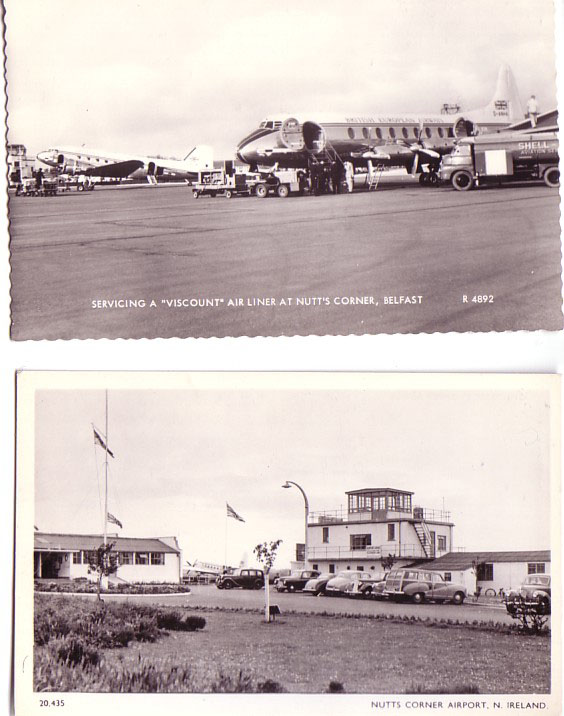
The others known are .... Richter 20.431 Terminal from airside with BEA DC-3 & Viking at left 20.432 Same but close up Viking behind DC-3 20.434 DC-3 G-AGIP close –up . Someone must have 20.433 ! Another Valentine is R4893, showing the viewing area with 2 BEA DC-3s. Nutts Corner was subsequently used for various forms of motor sport. Like Belfast, Glasgow has two airports, if you count Ryanair operations from Prestwick. Before Abbotsinch was opened for civil operations in 1966, the main airport was Renfrew. Unlike Nutts Corner, this had been developed with new buildings in the 1950s, so attracted a variety of RP publishers, with Valentine and the ML National Series prominent. Featured Renfrew cards are probably from the same photo shoot but with 2 gaps in the number series. Also a on-BEA Heron appears on 2 multi views among landsides, and an Aer Lingus DC-3 on 7 view D625. There is also a later D8162 with a BEA Vanguard.
Valentine D5168 – BEA Viscount 800 Boarding. Old colours on the aircraft but “Red Square” on the steps. G-AOYO from the name.
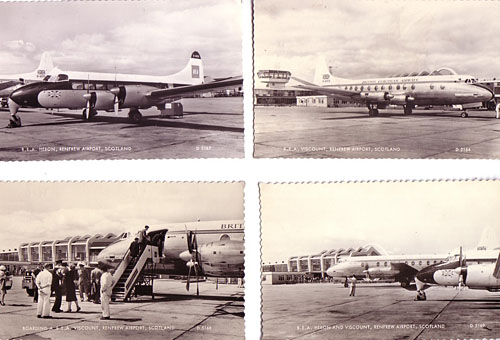
There is also some interest on the back of two of these. The Viscount boarding was mailed with a message written in a Loftleidir “big 4 engined airplane” (DC-4 or 6B) en route to new York via a midnight plane change in Reykjavik. The Heron is addressed to a Mr Stan Little c/o Queens Building Heathrow in 1960. Stan was the diminutive occupant of the commentary booth on the roof viewing area “Had two good flights on Saturday. We are getting around well in a Hillman Minx Convertible”. All those 4 cards show the 1954 terminal, the next Valentine shows the earlier building with BEA Viscount 700, DC-3s and Vikings and 2 other DC-3s which appear to be Manx G-AMZB and Hunting Clan G-AMSJ. The original card has damage to the lower edge which obscures the Card No. The combination of aircraft and buildings must be 1953/4.

The main feature of the 1954 buildings was the terminal in a style reminiscent of the 1951 Festival of Britain. The entrance is shown on this ML card. Another ML card has BEA DC-3 G-AJHZ landside of the new terminal.

After closure, the buildings remained derelict with nothing resulting from various proposals for re-use. They were demolished in 1978 and the site is now a Tesco. Other parts of the site are now part of Renfrew High School and the M8 motorway includes a runway. A building that was once car hire offices became the “Viscount” pub.. On the East coast of Scotland, Edinburgh did not have scheduled air service before 1947. The nearest it got was the grandly named Central Scotland Airport at Grangemouth. Opened with appalling timing in July 1939, it briefly had services to London and by KLM to Amsterdam before being taken over by the RAF. It closed in 1955. The card is another Valentine, A8749 and shows a RAF Training School Tiger Moth. The buildings were of a standard pattern for such establishments. The site was re-developed for industry but the hangar building , much modified, is believed to survive.
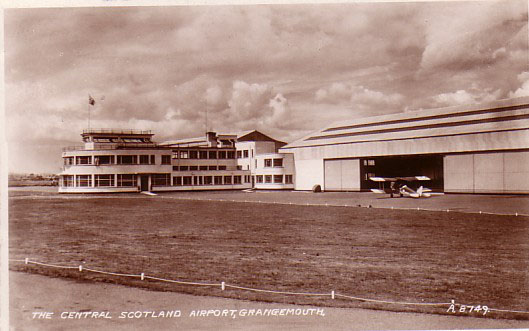
This completes the survey of aviation cards from the ex British territories of the Indian sub continent. Ceylon (Now Sri lanka) and Burma (now sometimes Myanmar) were separate colonies, while Bangladesh was originally East Pakistan, that state having been carved out of British India based on which areas had a muslim majority.
The two-part state of Pakistan collapsed, with some assistance from India in 1971. The new state of Bangladesh remains one of the most densely populated countries on Earth with high levels of poverty and vulnerability to sea level rises. Despite this it has operated an international service airline Biman Bangladesh since 1972 when it was set up by Ex PIA staff. International operations have used 707s, DC-10s, A310’s and currently 777. In the DC-10 era two cards were issued – the air view is oversize
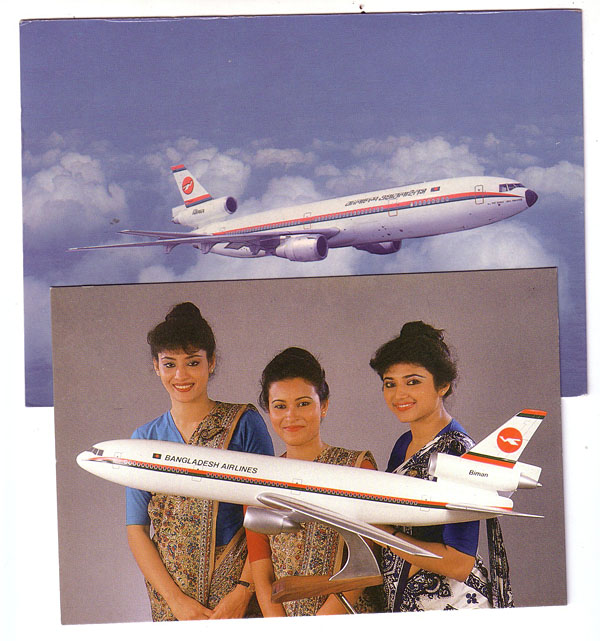
In the British era Burma was a staging post for both Imperial and KLM Far east services. This card from 1932/5 is of Akyab with a KLM Fokker FXVIII PH-AIQ which appears to be delivering or boarding a VIP of some sort as a guard of honour is present.
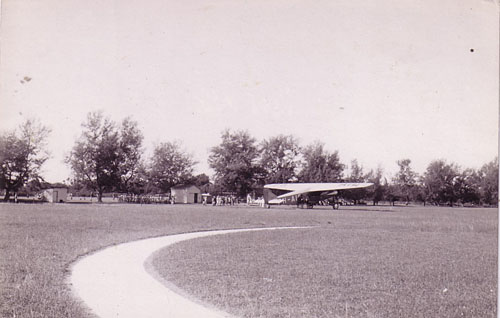
There was also an internal airline operating Short Scion floatplanes on the Irrawaddy but no cards have surfaced. If the post war Union of Burma airways did any cards then they are just as obscure so Burma is represented only by publisher cards until restyled Myanmar by the military government. Myanmar Airways and Air Mandalay have both issued various 737 and ATR cards, mostly large size. Other card issuers Air Bagan and Yangon Airways mean Myanmar remains an outpost of the airline-issue card. 75 years on the Fokker connection remains with Air Bagan F100s.

Ceylon had no pre war airline but after independence in 1948, Air Ceylon operated with aid from various airlines. The first was Australian national from whom DC-4s were leased for service to Europe.
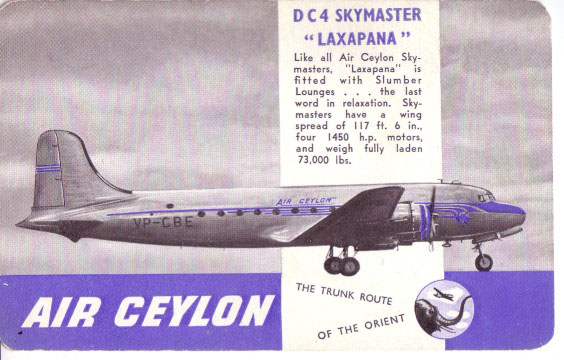
Next was KLM, whose period 1953/6 produced this classic Constellation + Crew card, which also appeared in a publisher version.

The KLM connection persisted through the Super Constellation, Electra and DC-8 era which unfortunately also covered the low point in KLM issued cards and Air Ceylon also suffered incredibly inaccurate renditions of its fleet by artist Victor Trip.
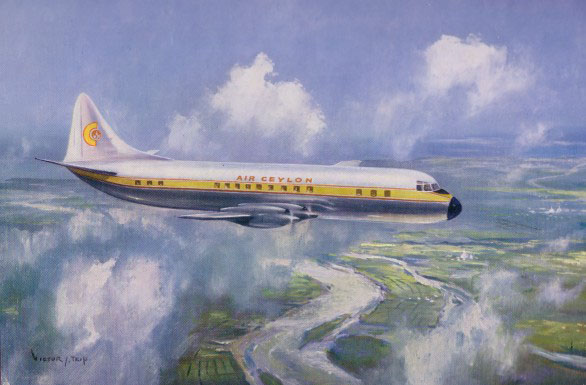
Next there was a relationship with BOAC from 1962-72, which may be connected with the decision to purchase a single Trident as on this large size card.
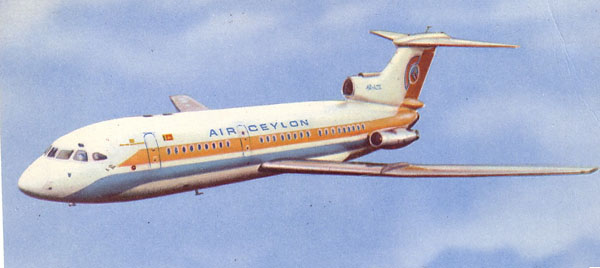
The final connection was with French carrier UTA 1972-8 who edited a DC-8 card into Air Ceylon colours.

Renamed Air Lanka in 1979 the airline then operated 707s, Tristars and 747s and finally A340s. The A340s experienced name change to Sri Lanken Airlines in 1998 when another management contract was made with Emirates. The 340’s and were joined by A330s which remain in service. In the Air Lanka/Sri Lanken era quite a large number of cards were issued, many in large format. The Emirates connection ceased in 2008.
|